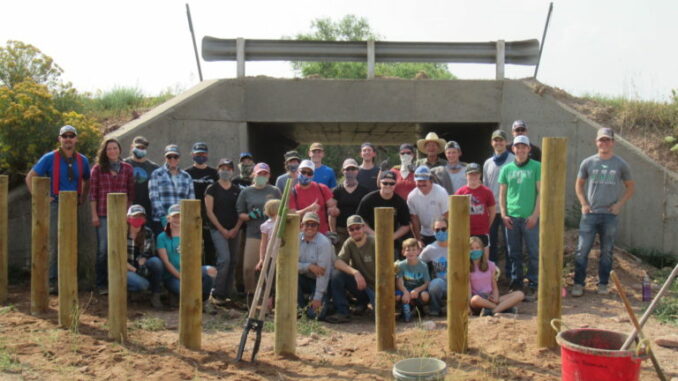
On the road, when a car comes up against wildlife, the car is going to win, and wildlife is going to lose. That’s according to Rick Knight, professor in the Human Dimensions of Natural Resources Department in the Warner College of Natural Resources at Colorado State University.
“The road density in America is immense; roads go on forever slicing across public and private lands, creating dangers for humans and animals alike,” Knight said. “There are many approaches to mitigate this issue, and one is to create wildlife crossings with simple, inexpensive materials.”
Over the last year, with funding from the Colorado Parks and Wildlife, Knight along with his students in an environmental conservation course and students and faculty from Front Range Community College built four wildlife-friendly crossings on two conserved ranches in Livermore, Colorado.
The students took down gates and fences that enclose livestock to install four crossings, two through culverts beneath roads and two along barbed-wire fences.
They utilized one of two innovative crossing designs at the sites. One design included vertical wooden posts 17 inches apart, a width that prevents cattle, horses, and mules from moving through while allowing wildlife like deer and elk to easily pass.
The second model included vertical uprights supporting a log placed horizontally 40 inches above the ground that wildlife can easily cross over or under while livestock cannot. The students then installed game cameras to capture wildlife using the new routes.
“With these devices, we can have peace on the range,” Knight said. “All of a sudden the landscape is permeable, and wildlife has the ability to move freely and safely across it.”
The exercise exposed students to hands-on designs for wildlife conservation and gave them valuable on-the-ground experience, said Sam Lewis, a teaching assistant in Knight’s NR120 course and a graduate student in the Fish, Wildlife, and Conservation Biology department.
“A lot of these students have been in classrooms most of their lives, and their connection to the natural world has been taught through a screen,” Lewis said. “It’s a really important aspect that this class gives students hands-on tools for conservation and restoration. It also provides a look at career pathways and creates a connection from themselves to our environment.”
Wildlife crossings and conservation on private lands
The wildlife crossings were installed by Knight and his students on the conserved Roberts Ranch managed by Zach Thode, and on private lands belonging to Knight and Thode, who happens to be his neighbor. Both Knight and Thode’s land support cattle, it is divided by county roads and highways and has plenty of wildlife activity, making it an ideal place to install the crossings.
For the past 25 years, Knight has studied private lands conservation in the American West; half of this land is privately owned. Private lands are biologically more productive than public lands, making wildlife disproportionately more dependent upon them, Knight said.
Because of this dependency, private landowners that practice conservation are up for the challenge. “It’s not an oxymoron how you could be a private landowner and a conservationist,” Knight said.
Thode had the idea that launched the construction of these wildlife crossings when he noticed a herd of pronghorn on his property whose migration was impeded by his barbed-wire fences. When there are no crossing points, many ungulates, like elk, will go directly through barbed wire fences, harming themselves and damaging fences — a costly concern for landowners, Knight said. Thode began looking for a solution to the issue.
“I wanted to make a corridor, but it would lead directly to the county road, so Rick and I did our research and came up with the plan to create the crossings,” Thode said.
Thode then gained funding for the project from Colorado Parks and Wildlife, and CSU and Front Range Community College students provided the volunteer labor to install the crossings.
“Over the past year, the game cameras have picked up deer and other animals crossing, but the success of the project wasn’t only reliant on animals crossing through,” Thode said.
“Seeing the animals cross through on camera was a sign of success,” he said. “The other measure of success was that close to a hundred college students got to see what resource conservation looks like on the ground.”
Thode said the future of private lands conservation in the long-term is policy-driven payment for ecosystem services. In the meantime, an effective short-term effort is to improve ecosystems through small-scale projects like animal crossings that have mutual benefit for wildlife and landowners.
“This project is passive, simple, and not difficult to take on,” Thode said. “It just takes landowners saying ‘Okay, we’re going to do these projects because it makes things better and safer for people and wildlife.’”
Support Northern Colorado Journalism
Show your support for North Forty News by helping us produce more content. It's a kind and simple gesture that will help us continue to bring more content to you.
BONUS - Donors get a link in their receipt to sign up for our once-per-week instant text messaging alert. Get your e-copy of North Forty News the moment it is released!
Click to Donate
